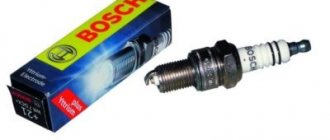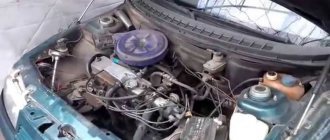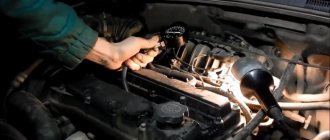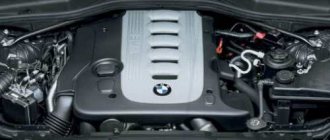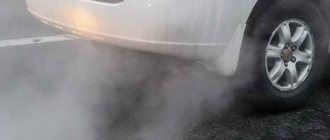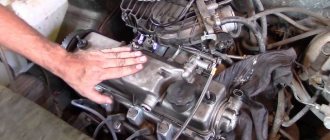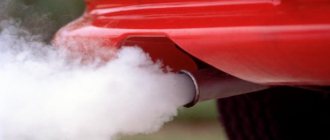Video review on the question “Why does Kalina trip when starting up”
After writing the article, I decided to also make a video review, where I told the whole story in detail. If my experience was useful to someone, I was happy to help.
Why the engine stall
Lada Kalina
Kalina engine is having problems - most of the drivers of this Russian car have encountered this problem. With all this, it should be noted that a similar problem is not a proprietary problem of this model, because it is quite common in both other Russian cars and foreign cars.
Troit in wet weather
The question very often arises: “Why does the engine stall in wet weather, that is, in high humidity?” Quite often, drivers have problems starting the engine in wet weather, and after an overnight stay, the car does not want to obey at all.
Especially in the morning, when everyone is rushing to work, a problem arises with the fact that the car either stalls or does not even show symptoms of operation, and everything lies in only one thing - excessive humidity. But how can you determine where moisture is very high and how it got there? If you just look under the hood, you are unlikely to find answers to your questions, so it will be very difficult to clearly notice damp spots.
How to figure out what is causing problems in wet weather?
If you have carried out a visual inspection of the car under the hood and did not see any wet places, as well as any indicators of damage, the first thing you should do is start the engine.
We achieve success only on the 5th, or even 10th attempt, the grip occurs only 4-5 times, in most cases, even 10 attempts are not enough to successfully start.
If you still start on the first try and do not observe any obvious problems, then you should let the car cool down, after which the problem will repeat. Only after a run of 10 km will the engine start up without causing any problems.
You can check in other simple ways to find the problem. To do this, you should park the car in an unlit place. After this, at night you should open the hood, after which your partner should turn the key to the start. And at this time you observe what processes are happening near high-voltage circuits. You will notice a seamless “northern lights”.
Signs of a malfunction
Kalina car has an engine problem
, this means that its engine only has 3 cylinders instead of 4. This is due to defects in the machine’s unit, which can manifest itself in the appearance of extraneous noise both when driving and while idling.
The main signs of “tripleting” are the following:
- failures to start the engine of various natures, accompanied by extremely strong vibrations transmitted to the vehicle interior;
- all cases when the engine ;
- blackening of one of the candles;
- a change in the sound of the exhaust, while an experienced auto mechanic can even determine by the sound of a running engine that it has some kind of defect;
- deterioration in the dynamic and speed characteristics of Kalina, a sharp increase in fuel consumption in all modes;
- “strange” readings from instruments, such as the tachometer;
- jerking during acceleration in any gear engaged.
If at least one of the listed signs appears, you should immediately stop using the car and send it for a comprehensive diagnosis. The fact is that the symptoms described can serve as signs of the appearance of a variety of engine defects, which can masquerade as other malfunctions. For example, a burnt spark plug may simply be replaced or cleaned by the car owner without identifying the reasons for this phenomenon, and at this time the car’s engine may already be seriously damaged.
It is worth talking separately about those cases when the presence of a malfunction is signaled by the automatic diagnostic system installed on Kalina. If the engine icon lights up on the dashboard, you should immediately stop driving and call a tow truck to transport the car to a car service center. The fact is that it is there that they can reliably decipher the sensor readings and establish why the check engine light is on.
The main consequences of operating a “triple” engine can be increased wear of its rubbing parts, that is, rings, piston and cylinder. The fact is that the idle cylinder still receives gasoline, which washes away the protective layer of oil from them. As a result, it is quite possible that the entire cylinder will have to be replaced, and in the worst case, the same fate awaits the entire power unit.
What to do first if the engine seizes up
Summarizing all of the above, we can draw up small instructions on what to do if symptoms of a throbbing engine appear.
If the engine shakes more when starting or when cold, you need to start your search by checking the spark plugs and high-voltage wires. If the problem becomes more pronounced after warming up or under load, it is better to first check the condition of the air filter.
It is better to check other possible reasons as the work becomes more complex. » alt=»»>
Almost every car enthusiast sooner or later encounters such a fairly common malfunction of the internal combustion engine, when the engine stalls. As a rule, in certain situations the engine stalls when hot or only when cold, and tripping can also occur constantly (regardless of the temperature of the power unit, operating mode, load level, etc.).
In short, engine tripping means that one or more cylinders are not firing, and there can be several reasons for such a malfunction. In this article we will talk about why the engine stalls after warming up, how the malfunction can be diagnosed, and what signs help to accurately identify the problem.
Read in this article
Prevention of car engine tripping
Prevention of such a phenomenon as engine “triplication” is that the car owner needs to promptly eliminate the most common malfunctions of the engine, as well as other related systems. To do this, it is necessary to strictly adhere to the periodic maintenance schedules established by the manufacturer for the vehicle. At the same time, if you have little experience in owning a car, it is better not to engage in serious technical work yourself, but to entrust their implementation to experienced specialists.
In addition, it makes sense not to delay carrying out prevention at the first deterioration in engine performance, attributing them, for example, to low-quality gasoline. At the same time, all preventive measures should be carried out only in those auto repair shops where experienced craftsmen work. For example, incorrectly set ignition timing can lead to the appearance of “triple”. Unqualified service station employees very often sin with this, especially if the car owner is a novice behind the wheel and has little understanding of the technical side of the matter.
In the same case, when all systems and components of Kalina work correctly, the “triple” effect should not occur. In this case, the service life of the engine should be significantly reduced, since the power unit, in which one of the cylinders is inoperative, may experience increased loads, leading to its accelerated failure.
It is worth mentioning the Traffic Rules, which directly prohibit the operation of a vehicle with a faulty engine. Therefore, it is better not to risk either money or rights, and if a “triple” effect occurs, immediately send the car for repairs.
Problems with cars are always unpleasant, and when the 8-valve engine on a Kalina, which has not yet driven 50,000 kilometers, fails, it is also insulting. But this problem does not appear immediately, but only when the engine warms up a little. Then the “engine malfunction” light starts flashing.
Turning off the ignition and restarting the car immediately solves the problem. Or rather, it stops for a minute, but then the games with nerves begin again.
How to protect from water when washing
The best remedy is, of course, not to wash the engine. But how to remove oil stains? There are several ways. The most neutral one, which does not lead to consequences, is to buy a grease remover from dishes in a store, spray it on and wait a few minutes until everything drips down. Then use a compressor to thoroughly blow through all engine parts. But no moisture or water.
The second way is to mix a little gasoline with mallow - a product that many car mechanics use to wash their hands, pour this mixture into a spray bottle, spray it on the engine and also air dry.
Finding the cause of the malfunction
The engine starts to stall when the fuel pump malfunctions and does not pump in the required amount of fuel, or when it does not burn completely. The substrate of the first case is not only the fuel pump itself, but also the conductive system. And the second reason may be related to problems with the ignition system, spark plug carbon, or improper operation of the engine valves.
If the fuel system is not working properly
, the feeling that the engine is stalling will develop a minute after the start, and then will only increase. If there is a narrowing of the pipeline, or there is no power to the fuel pump, such problems are not uncommon. You can check this after exposing the relay: start the engine, check the functionality of the pump and relay. In this case, the on-board computer will not show errors.
If there is a problem in the valve apparatus itself, in the spark plugs or in the ignition system, it will also manifest itself. Namely: the engine will start normally, but a moment later it will start to stall. Similarly, the power unit fault light should light up, because standard sensors perceive an excess (or lack) of fuel.
When such interruptions in the fuel supply occur, twitching develops, because the amount of gases produced in different engine operating cycles varies.
Elimination methods
To eliminate the tripping effect on a vehicle, you need to have enough time, since it may take a whole day, as well as tools. To work, you will need a set of wrenches, screwdrivers and heads, as well as a multimeter. So, let's look at how to troubleshoot problems that have arisen.
The on-board computer recognizes a poor-quality mixture by the combustion process. But that's not the worst thing. Poor quality gasoline can clog elements throughout the system. The consequence of long-term use of this type of fluid can lead to the valve mechanism, as well as the pistons, burning out. In this case, major repairs become inevitable, since parts wear out at an accelerated rate.
If it is discovered that the gasoline is of poor quality, the motorist will face a whole range of repair operations, namely:
- Cleaning the fuel tank and replacing the filter.
- Cleaning or changing spark plugs.
- Dismantling and checking injectors.
- And finally, disassembling the cylinder head.
After cleaning, you need to fill it with high-quality gasoline and drive it. The CHECK icon should turn off on its own when high-quality fuel enters the system.
Problems with valves on Lada Kalina
On the 8-valve Lada Kalina engine, the valves are less reliable than on the 16-valve version. This is a design flaw of engineers that car enthusiasts will have to deal with.
For diagnostics, you will need to at least look at the electronic control unit and compression in the cylinders. This will have to be done at a car service center, where computer diagnostics will initially be offered (see the article “What is included in engine diagnostics”).
Often, there is no result that can be relied upon to fix the problem, because the source of the breakdown is not in the sensors, but in the mechanical part of the car. Therefore, you will have to measure the compression in the cylinders. If it is normal, you need to remove the engine valve cover and inspect the gap between the valves. Its normal value is 0,2-0,35
.
It is important to set the valve clearance in this range, after which the engine stops running and the “engine malfunction” light goes out. By the way, valve adjustment for Kalina is required every 60,000-70,000 kilometers. But when gas is used as fuel, they need to be adjusted more often - every 20,000-30,000 km.
The engine stalls, the check light flashes or lights up: the main reasons
Let's start with the fact that injection engines are equipped with special catalyst devices for cleaning the exhaust. At the same time, the catalytic converter is a rather vulnerable and at the same time expensive element, and all sorts of malfunctions in the engine create a risk of damage.
As a rule, the check flashes when there is a risk of damage to the catalyst. In this case, the simultaneous tripping of the engine means that one or more cylinders are not working or are not working correctly. In practice, this means that the fuel in the problem cylinder does not burn completely, after which it enters the exhaust system.
As a result, the remaining unburnt fuel burns out in the area where the catalyst is located, since the temperatures there are very high. Fuel also gets on the catalyst itself, causing it to fail.
It becomes clear that the check often lights up when problems arise with the combustion of the mixture in the cylinders. It is not difficult to guess that such combustion can be disrupted for a number of reasons, ranging from problems with the ignition or fuel supply system to lack of air in the intake, air leaks, reduced compression in the engine cylinder, etc.
It should be added that the check also often lights up in the event of failure of any ECM sensors. One way or another, it is quite obvious that the “check” in the vast majority of cases indicates either problems with the electronic engine control system itself, or the risk of damage to the catalyst due to malfunctions of the internal combustion engine.
It is important to understand that the engine tripping indicates a non-functioning cylinder. In this case, the check is flashing not due to the failure of any ECM sensor, malfunction of the exhaust gas recirculation system or poor fuel in the tank, but rather signals to the driver about a direct threat to the catalyst
In a nutshell, fuel that is not burned and gets into the outlet causes a special sensor (lambda probe, oxygen sensor) to send readings to the ECU indicating deviations from the norm. The control unit begins to try to correct the situation, but taking into account the tripping, it is simply not able to adjust the operation of the motor so that everything returns to normal. As a result, fuel consumption increases, while the engine operates unstably, idle speed fluctuates, etc. In some cases, the motor “falls” into emergency mode.
This mode is necessary in order to minimize damage to the catalyst and the internal combustion engine itself. In practice, this is expressed in such a way that although the driver presses on the gas, the car in emergency mode with the “check” on still does not accelerate above 30-40 km/h, the crankshaft does not spin up, engine traction disappears, etc.
This feature of engine operation is primarily aimed at preventing burnout or melting of the catalyst. The catalyst itself consists of small honeycomb cells. If unburned fuel intensively enters the exhaust and burns out in the catalyst, the element will simply melt.
This melting will lead to the fact that exhaust gases will not be able to pass normally through the catalyst, that is, a plug appears in the exhaust pipe. Naturally, the engine will “suffocate”, power will drop, the engine may not start at all, etc.
Also, the catalyst will no longer be able to clean the exhaust, and toxicity will increase. There is only one way out in this situation - repairing the engine to eliminate the main cause of the engine tripping, and only then replacing the expensive catalyst with a new one. To minimize risks, a special program is programmed into the ECU, which involves operating the engine in emergency mode.
Similar problems
Other problems may also occur besides those described above. When the 8-valve engine on Kalina fails, the culprit of the problem may also be the ECU, which in this model is placed very poorly. If the owner did not wrap it with film, the contacts could oxidize, and conductivity through them could slow down or disappear altogether. The on-board computer will say the same, producing various errors.
Occasionally, it happens that antifreeze gradually seeps into the electronic control unit through a bunch of wires. Moreover, outwardly the ECU will look dry, although aggressive liquid gradually gets inside it. Therefore, the driver needs to open the block housing and inspect the contacts.
Faulty spark plug
An accompanying symptom that confirms the hypothesis that the cause is the spark plug is the fact that a cold engine trots more strongly. After warming up, the problem often disappears or becomes less pronounced.
First of all, you should pay attention to the color of the central electrode insulator. Determining a normally working spark plug is not difficult
A normal insulator is light or slightly brownish. If the color of the insulator is different from normal, then you need to find out why. Traces of oil or carbon deposits on the insulator indicate that an over-enriched mixture is entering the cylinder, which floods the spark plug, or it is “filled” with oil. As a result, normal sparking is disrupted.
The reasons for this may be different:
- the engine idles a lot when warming up;
- the check valve of the power supply system is faulty;
- low compression in the cylinder;
- impaired valve timing;
- malfunctions in the operation of injectors;
- failure of the oxygen sensor.
After the insulator, you should inspect the spark plug body. It must be intact, without chips or cracks
Particular attention should be paid to the presence or absence of vertical black stripes and black dots. If they are, the spark plug is broken and needs to be replaced.
Finally, the quality of sparking is checked. Moreover, simply connecting the side electrode to ground is not enough, in this way you can only check the performance of the spark plug. To understand how well the spark plug works, you need to hold it at a distance of one and a half to two centimeters from the ground and turn on the starter.
You can also find videos on the Internet with detailed instructions for checking spark plugs.
FakeHeader
Comments 41
Here's what to do if the spark plugs are changed 3-4t.km. back (at maintenance) When the problem arose for the first time, they changed the coil in the second cylinder, but after 3 days the problem came out again - they cleaned all the injectors, replaced the fuel filter, but after 3 days the same problem again...
does the CHECK appear on the dashboard?
Yes, it appears when starting it cold and warming up for a couple of minutes and there it is. I turned it off, started it, and it seemed to be running normally. It started even without checks, it just started and stalled right away, there were still frosts (autostart), it started up again normally. Then it started to start and stalled not immediately, but after some time (also with autostart) it was back to normal. Then I started it with the key - and saw a check; when I start it again, it disappears. The check came out about 10 minutes later, everything was fine again. And it simply stalled in a traffic jam. And well, the funniest thing is - pp.userapi.com/c639719/v6...444/44518/bajmD9S-lkk.jpgThe dashboard allows you to connect an external temperature sensor, but of course I don’t have one, and there was very surprised. There are two options - either -40 or points
1) Regarding the temperature sensor, not all trim levels have it. Buy and connect) What is the error number?
2) Regarding the stalling, this is a jamb of the factory firmware, specifically for Grants with automatic transmission. Here is an excerpt from the Za Rulem magazine article “The same Jatco JF414E automatic machine works on the Grant and the mi-DO hatchback. The editorial mi-DO made me suffer: sometimes when braking or even in leisurely walking mode, the engine suddenly stalled. To restart it, it was necessary to put the machine into “parking”, and this can only be done by stopping completely! The reason for the vagaries lay in the fact that initially the engine calibrations were calculated for the version with a manual transmission, but for a car with an automatic transmission they were not the best fit: the mechanical losses of the transmission were not taken into account, which are much higher in hydromechanics. ————-We managed to push through solution to the problem at the factory level: a diagnostic unit was installed in the editorial car, which we drove with for several months. Decryption made it possible to catch errors, and mi-DO received new firmware for the engine control unit. Now this program has gone into series: with its appearance, other unpleasant symptoms of automatic Datsuns have disappeared. The engine speed no longer drops during heavy braking, and the cramps that shook the car when the air conditioning was turned on have disappeared.”
Sometimes you get into the car, the key is turned to start, and the engine barely spins up, vibrates a lot, and troits, the check light comes on. However, as the engine warms up, it starts to run smoothly. But it jerks when moving under tension, or during rapid acceleration. With such symptoms, the first thing you need to do is, of course, read the error codes. If you have an on-board computer, then this is not a problem at all, if not, diagnostics via the connector will help
Most often we will see two typical errors:
0363 - Misfire detected, fuel supply to idle cylinders is turned off
1303 - Cylinder 3, misfire detected, critical for the converter
In addition, we can get the following:
0300 and 0303 - Checking for misfires that affect toxicity. The number of misfires is greater than the threshold value
Full set of possible errors:
P0300, 0302, 0363, 1302, 0301, 1301, 0346, 1303
So, the problem should be looked for in this order:
4. Ignition module.
In 60% of cases, everything is solved by replacing the spark plugs with new ones; in rare cases, they pull wires along with them; the worst option is burnt-out valves, but this needs to be ruled out by measuring compression. In order to exclude the mass air flow sensor or the ignition module without losing money, I recommend taking them for analysis with the condition of being able to return them, or from the corefan, if he has a mark or a four. Good luck to everyone on the roads and fewer breakdowns.
The reason that error 0363 appears on the VAZ 2114 is the so-called misfire. It is the absence of an electric spark at the spark plug of one of the cylinders, as a result of which only three cylinders are involved in the operation of the engine.
Externally, tripping looks like a large loss of power, sharp jerking of the car and strong exhaust sounds. In most cases, the car will not even be able to move. This phenomenon can occur either periodically or constantly.
The reasons may be:
- lack of spark on the cylinder spark plug;
- poor quality fuel-air mixture;
- damage (burnout) of the gasket;
- damage to the cylinder itself.
We will consider the first of these reasons (misfire) below.
Checking the ignition coil and its circuits on VAZ 11183, VAZ 21116 and VAZ 11186 Lada Granta engines
Tool:
Tester
Parts and consumables:
- Probe with 1-2 W lamp
- Ignition switch contact group (if necessary)
- Ignition coil (if necessary)
- Bare wire
1. With the ignition switch OFF, disconnect the engine management system wiring harness connector from the ignition coil as described here.
2. To check the coil power circuit, connect the tester probes to the middle terminal of the harness block and the engine ground. When the ignition is turned on, the device should record a voltage approximately equal to the battery voltage.
Note:
If there is no voltage at the middle terminal of the wiring harness block, then the wire connecting the block to the ignition switch is probably faulty or the lock contact group is faulty.
3. To test the coil control circuits, you can use a probe with a 1-2 W lamp. Relieve pressure in the engine supply system and do not replace the fuel pump fuse. Connect the probe probes to the middle and one of the outer terminals of the wiring harness block. If the control (and power) circuit is working properly, the probe light should blink frequently when cranking the crankshaft with the starter.
Note:
Otherwise, check for a break or short to ground in the wire connecting the outer terminal of the block to the controller terminal.
4. Similarly, by connecting the probe probes to the middle and other extreme terminals of the block, check the other ignition coil control circuit.
5. You can check the serviceability of the ignition coil itself on the engine by disconnecting the wiring harness block and high-voltage wires from it. For clarity, we show the test on a dismantled coil. It is necessary to connect the device wires to the module contacts, which are located at the edges. That is, to the extreme left and right. Using an ohmmeter, check the circuit for an open circuit.
Note:
If the multimeter readings do not change after connecting the wires, this indicates that there is an open circuit in the circuit.
6. To check for breakdown (short to ground) of the primary windings, connect the tester probes to the middle terminal of the coil and to the metal part of the coil body.
Note:
If the circuit of the primary windings is working properly, the tester should record the value “infinity”.
7. To check for a break in the secondary winding of the ignition coil, connect the tester probes to the paired high-voltage terminals of the coil (terminals 1-4 or 2-3 cylinders).
Note:
For a working ignition coil, the tester should record a resistance of about 4.0 kOhm. If the secondary winding breaks, the tester will show “infinity”.
8. Check the other secondary winding of the ignition coil in the same way.
9. Check the secondary windings of the ignition coil for breakdown on the engine. Relieve pressure in the engine supply system and do not replace the fuel pump fuse.
10. To test, you will need two known good spark plugs. Tie the spark plug bodies together with a piece of bare wire (“massage”). Connect the paired terminals of the ignition coil with the spark plugs using serviceable high-voltage wires and place the spark plugs on the cylinder head cover.
11. Turn the crankshaft with the starter. If the ignition coil is working properly, sparks should regularly jump between the electrodes of the spark plugs.
Note:
To avoid electric shock, do not touch spark plugs or high-voltage wire tips.
12. Similarly, by connecting the high-voltage wires to the other two paired terminals of the coil, check the other secondary winding for breakdown.
The article is missing:
- Photos of parts and consumables
- High-quality photos of repairs
How to determine which cylinder is not working
To determine a non-functioning cylinder on a Lada Kalina, you can use two methods: computer diagnostics or hearing.
To determine a non-functioning cylinder using diagnostics, you need to connect a special scanner to the OBD connector and read readings from the operation of the internal combustion engine.
You can also determine a faulty cylinder by the sound of the engine; to do this, you need to remove the connectors from the ignition coils one by one and listen to the engine. For example, when the engine is revving, you need to remove the connector from the first ignition coil; if the engine speed starts to drop or the sound of the engine changes, then this cylinder is working, put the connector back in place and remove it from the second coil, and so on until, when removing the connector from ignition coils, the operation of the engine will not change, this will mean that this particular cylinder is not working at the moment.
